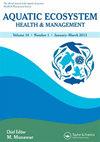The Rouge River Area of Concern - A multi-year, multi-level successful approach to restoration of Impaired Beneficial Uses
IF 0.8
4区 环境科学与生态学
Q4 ENVIRONMENTAL SCIENCES
引用次数: 3
Abstract
Citizen outcry in the 1960s led to passage of the 1972 U.S. Clean Water Act. Expansion of industrial permitting and availability of federal grants to municipalities controlled industrial waste and untreated municipal sewage entering the Rouge River. However, many sources persisted – notably wet weather discharges, stormwater runoff, and contaminated sediments. This remaining pollution led state officials to cooperatively craft the Rouge River Remedial Action Plan in 1985. This plan addressed all pollution sources, but was not substantially implemented until 1993 when the federal government, encouraged by Congressmen Dingell and Knollenberg, committed to the Rouge River National Wet Weather Demonstration Project. The federal government ultimately delivered $350 million that was matched by $700 million in local funds. Efforts have been sustained through multi-year state and federal grants, with additional funding from local communities and other stakeholders. Early focus of the Rouge Project was on untreated sewage from combined sewer overflows, but quickly expanded to address other impairments from sanitary sewer overflows, stormwater runoff, illicit connections and failing septic systems. With major sewage discharges under control, efforts shifted to remediating contaminated sediments and improving in-stream water quality and habitat. In total, over 380 projects were completed by 75 communities and agencies at a cost of over $1 billion since 1988, resulting in improved water, sediment, and biological quality. Prior to the U.S. Clean Water Act, the Rouge River nearly continuously failed to meet water quality standards. After decades of effort and investment, it now rarely violates standards. This miraculous recovery was initiated by a small handful of citizens, facilitated by local municipal leaders, and supported by the federal government. The Rouge River is a model for how a holistic, ecosystem approach to water pollution can result in cost-effective and greater and faster achievement of restoration, while meeting local needs.关注的鲁日河地区——恢复受损有益用途的多年、多层次成功方法
20世纪60年代公民的强烈抗议导致1972年 《美国清洁水法》。扩大工业许可,并向进入鲁日河的受控制的工业废物和未经处理的城市污水提供联邦拨款。然而,许多来源仍然存在——特别是潮湿天气的排放、雨水径流和受污染的沉积物。这种残留的污染导致州政府官员在1985年合作制定了胭脂河修复行动计划。该计划涉及所有污染源,但直到1993年联邦政府在国会议员丁格尔和克诺伦伯格的鼓励下,致力于鲁日河国家潮湿天气示范项目,才得到实质性实施。联邦政府最终提供了3.5亿美元,与之相匹配的是7亿美元的地方资金。通过多年的州和联邦拨款,以及当地社区和其他利益攸关方的额外资助,这些努力得以持续。Rouge项目早期的重点是联合下水道溢流产生的未经处理的污水,但很快扩大到解决卫生下水道溢流、雨水径流、非法连接和化粪池系统故障造成的其他损害。随着主要污水排放得到控制,工作转向修复受污染的沉积物,改善溪流水质和栖息地。自1988年以来,75个社区和机构总共完成了380多个项目,耗资超过10亿美元,从而改善了水、沉积物和生物质量。在美国《清洁水法》颁布之前,鲁日河几乎一直达不到水质标准。经过几十年的努力和投资,它现在很少违反标准。这一奇迹般的复苏是由少数公民发起的,得到了当地市政领导人的推动,并得到了联邦政府的支持。Rouge河是一个模型,展示了如何通过整体生态系统方法来解决水污染问题,从而在满足当地需求的同时,实现成本效益高、更大、更快的恢复。
本文章由计算机程序翻译,如有差异,请以英文原文为准。
求助全文
约1分钟内获得全文
求助全文
来源期刊

Aquatic Ecosystem Health & Management
环境科学-海洋与淡水生物学
CiteScore
1.70
自引率
0.00%
发文量
1
审稿时长
18-36 weeks
期刊介绍:
The journal publishes articles on the following themes and topics:
• Original articles focusing on ecosystem-based sciences, ecosystem health and management of marine and aquatic ecosystems
• Reviews, invited perspectives and keynote contributions from conferences
• Special issues on important emerging topics, themes, and ecosystems (climate change, invasive species, HABs, risk assessment, models)
 求助内容:
求助内容: 应助结果提醒方式:
应助结果提醒方式:


